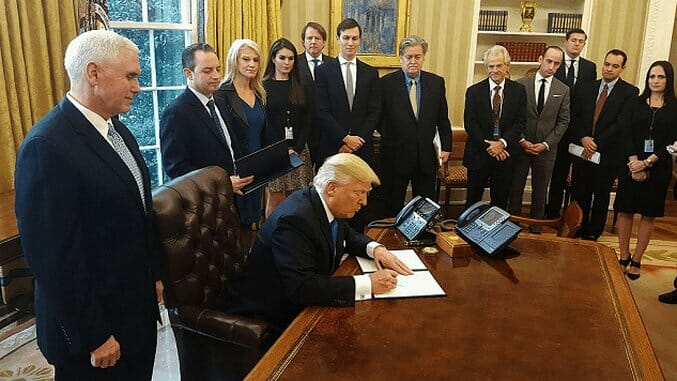Dissecting Trump: New Budget, Same Destruction to Science

Remember President Trump’s plan to gut American science in his first budget proposal released just a few months ago? Do you remember the scientific outcry from such a proposal and the “marches for science?” It turns out President Trump doesn’t. Released earlier this month, his full budget proposal for 2018 requests billions of dollars be removed from the numerous funding and research agencies that drive American innovation, ensure a healthy populace, and guarantee at least some semblance of safety.
The planned cuts total nearly $5.8 billion in funding from the National Institutes of Health (NIH)—or, put more radically, 18 percent of the agency’s total budget. The cuts will also oust hundreds of millions of dollars from programs at the CDC, some $841 million from the National Science Foundation, the agency primarily responsible for funding scientific research, and even more destruction to NASA’s Earth Science division—those pesky nerds and their fight against climate change. The agency hardest hit by the cuts would be the Department of Energy which would see 52 percent of its budget eviscerated.
Despite looking disastrous for scientific research, Congress controls the future of Trump’s proposal; however, if this budget were to pass, this is a glimpse of the damage to the country’s science agencies:
![]()
Why should the CDC fight infectious diseases?
Zika, HIV/AIDS, any plague that’ll kill a third of the population – why prepare or find cures? The President announced $333 million in cuts to the Centers for Disease Control and Prevention, which, according to John Auerbach, president and CEO of the Trust for America’s Health, to NPR, “would be perilous for the health of the American people.”
“From Ebola to Zika to opioid misuse to diabetes to heart disease, the CDC is on the front lines keeping Americans healthy.”
In total:
—The proposal largely hurts programs responsible for curbing the spread of infectious diseases like the flu, HIV/AIDS, hepatitis, tuberculosis (diseases gone retro!), and zoonotic diseases like Zika or the black death—which seems like a better way to go than global warming.
—$136 million in cuts to the CDC Office of Public Health Preparedness and Response, the sector tasked with responding to public health emergency like, say, the soon-to-be effects from the near-endless fracking.
—$76.3 million to the CDC’s Center for Global Health, which aims to eradicate infectious diseases worldwide.
-

-

-

-

-

-

-

-

-

-

-

-

-

-

-

-

-

-

-

-

-

-

-

-

-

-

-

-

-

-

-

-

-

-

-

-

-

-

-

-








































